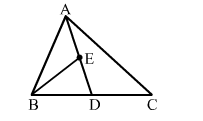In ∆ABC, if D is the midpoint of BC and E is the midpoint of AD, then ar(∆BED) = ?
(a) $\frac{1}{2} \operatorname{ar}(\Delta A B C)$
(b) $\frac{1}{3} \operatorname{ar}(\Delta A B C)$
(c) $\frac{1}{4} \operatorname{ar}(\Delta A B C)$
(d) $\frac{2}{3} \operatorname{ar}(\Delta A B C)$

(c) $\frac{1}{4} \operatorname{ar}(\triangle A B C)$
Since D is the mid point of BC, AD is a median of ∆ABC and BE is the median of ∆ABD.
We know that a median of a triangle divides it into two triangles of equal areas.
i.e., $\operatorname{ar}(\Delta A B D)=\frac{1}{2} \operatorname{ar}(\Delta A B C)$ (i)
$\Rightarrow \operatorname{ar}(\triangle B E D)=\frac{1}{2} \operatorname{ar}(\triangle A B D)$ ...(ii)
From (i) and (ii), we have:
$\operatorname{ar}(\Delta B E D)=\frac{1}{2} \times \frac{1}{2} \times \operatorname{ar}(\Delta A B C)$
$\therefore \operatorname{ar}(\Delta B E D)=\frac{1}{4} \times \operatorname{ar}(\triangle A B C)$
